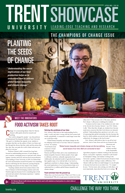Obsidian artefacts are an invaluable tool in archaeologists’ research of pre-historic communities, explained McMaster University anthropology professor Dr. Tristan Carter at last Thursday’s annual Kenneth Kidd Lecture, held in Bagnani Hall. According to Professor Carter, however, these artefacts are not being used to their fullest potential.
Obsidian, a natural glass formed under certain volcanic conditions, was highly-valued by pre-historic populations who used it for tools and ritual objects, exchanging and circulating it over long distances from an early date. Because the obsidian produced from each volcano is chemically unique, archaeologists, using scientific techniques, can establish the provenance, or source, of a site’s obsidian relatively easily by matching its elemental fingerprint to that of a specific volcanic source, allowing them to map the spread of obsidian throughout the pre-historic world.
According to Prof. Carter, this process, called obsidian sourcing, is arguably the success story of archaeometry (or scientific archaeology). However, this success, suggested Prof. Carter, has tended to overshadow other types of investigation that can offer equally valid insights. “While the analysts, the scientists and the geo-archaeologists should be justifiably proud of their methodological developments, regional coverage, and analytical rigour, the archaeologists have somewhat dropped the ball with regard to the big picture, social science questions that we should be asking through our material.”
The problem, argued Prof. Carter, is compounded by the publishing requirements of specialized journals that focus on archaeometric data divorced from narrative and descriptive observations about an artefact’s appearance, form, technology, archaeological find location, and other contextual information. “Why is it,” asked Prof. Carter, “that as soon as we introduce science into the equation, our archaeological sensibilities fly out the window? We have become seduced by technology and science at the expense of big picture archaeological questions,” he maintained. “We need to acknowledge that we are dealing with artefacts, not samples, and that they have far richer characters than their geo-chemistry.”
The mere presence of the same type of obsidian at different sites has been used to imply connections between pre-historic communities, explained Prof. Carter. In his own work Prof. Carter intends to interrogate these assumptions. By combining archaeometric data with the archaeologist’s narrative sensibilities, he will attempt to identify common traditions of consumption and communities of practice within the pre-historic eastern Mediterranean world - connections that archaeometric sourcing of obsidian alone have been unable to establish. In particular, his research will look to answer some of the questions surrounding the nature of Göbekli Tepe, the ‘world’s first temple complex’ in the Urfa region of eastern Turkey.
These connections, he hopes, will help to answer those “bigger picture” archaeological questions such as how neolithization - or the spread of farming - occurred. “I think we have to remember that Colin Renfrew (one of the initiators of obsidian characterization studies in the 1960s) was only analyzing obsidian as a means to an end, and that end was the reconstruction of pre-historic socio-economic systems. It is through developing projects that thoughtfully meld archaeometric practice and theoretically-driven archaeological questions ultimately I hope that our work can return to the lofty goals of those who initiated obsidian characterization studies some 50 years ago.”
Professor Carter is an associate professor of anthropology at McMaster University. Recently, his work has focused on the procurement, exchange, transformation, use, and discard of obsidian by various pre-historic populations in the Eastern Mediterranean from the early Epipaleolithic up to the end of the Bronze Age.
The Kenneth Kidd Lecture series is named for the late Kenneth E. Kidd, the first chair of Trent's Anthropology Department. Lectures in this series are given by visiting guests, Trent faculty and research fellows, and graduate students in Anthropology.
Posted on Wednesday, February 1, 2012.


































